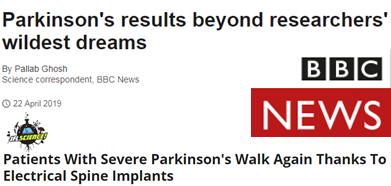HYPE?
Media portrayal:

HOPE?
Scientific interpretation:
Spinal Cord Stimulation Phase I trial for Parkinson’s Freezing of Gait
Original article: Spinal Cord Stimulation Therapy for Gait Dysfunction in Advanced Parkinson’s Disease Patients, Movement Disorders: February 14, 2018.
The takeaway
Significant improvements in walking and a reduction in freezing has been reported in a small, open-label study involving a group of five people with Parkinson’s undergoing spinal cord stimulation.
Why is it important?
Spinal cord stimulation may offer relief from difficulties in walking, balance and freezing which are not responsive to levodopa treatment and so represent an important unmet need in Parkinson’s.
Impact Opinion
“This is a very interesting development, but we must be cautious in not reading too much into the results. Thus far, spinal cord stimulation has only been tested on a small number of people with Parkinson’s and only in an open-label fashion. A larger validation of this technology is now required. If spinal cord stimulation proves to be efficacious, then this could represent a new treatment option for people living with Parkinson’s which may improve quality of life for those who suffer from freezing of gait.”
Background
Spinal cord stimulation (SCS) involves the delivery of small amounts of electrical current onto the spinal cord from a small stimulator placed under the skin. It is normally used in neuropathic pain, when medications and other methods no longer offer any relief. It works by interfering with pain signals as they are transmitted up the spinal cord and into the brain.
The first reports of beneficial effects of SCS in people with Parkinson’s emerged in 2012, when a patient treated for pain showed improvements in movement. More recently, a study in 5 patients investigated directly and using objective measures, whether SCS could improve walking and reduce freezing, or episodes of inability to move the feet and become stuck when walking. These symptoms are notoriously difficult to manage and do not generally respond to levodopa treatment.
The details
Five people with Parkinson’s, ranging from 63-85 years in age and who had at that point lived with the condition for 14 years on average, had two cylindrical electrodes placed at the level of the thoracic spine, corresponding roughly to the small of their back. Using a remote control, each participant was instructed to set the device daily at an intensity which was 3-5% higher than the minimum, producing paresthesias over the legs and feet while standing. Paresthesias are abnormal sensations like tingling caused by nerve stimulation, and are a secondary, unavoidable effect of SCS but a useful way to tell that appropriate contact is made.
The participants underwent a number of tests on 9 occasions, before they had the electrodes implanted as a baseline measure, and subsequently over the course of 6 months, during which they used the stimulator and continued taking levodopa. In addition to the standard UPDRS assessments, a number of different features of walking and freezing episodes were recorded.
Using objective gait technology to measure changes, the participants showed sustained improvements in gait measures including stride length and time, and how fast they could go from sitting to standing. They also had a substantial reduction in freezing episodes, which went from 16 on average down to none at 6 months.
Next steps
These encouraging results now need to be put to a formal test using a double blind randomized design with more participants over a longer time period.
Original article: Spinal Cord Stimulation Therapy for Gait Dysfunction in Advanced Parkinson’s Disease Patients, Movement Disorders: February 14, 2018. Samotus, O, Parrent, A, Jog, M.



